The AMD Radeon RX 480 Preview: Polaris Makes Its Mainstream Mark
by Ryan Smith on June 29, 2016 9:00 AM ESTPower, Temperature, & Noise
Given AMD’s focus on power efficiency with Polaris – not to mention the overall benefits of the move to 14nm FinFET – there is a lot of interest in just how the RX 480 stacks up when it comes to power, temperature, and noise. So without further ado…

When it comes to idle power consumption I'm posting the results I've measured as-is, but I want to note that I have low confidence in these results for the AMD cards. Ever since the GPU testbed was updated from Windows 8.1 to Windows 10, AMD cards have idled 3-5W higher than they used to under Windows 8.1. I believe that this is an AMD driver bug – NVIDIA’s cards clearly have no problem – possibly related to the GPU tested being an Ivy Bridge-E system. In this case I don’t believe RX 480’s idle power consumption is any higher than GTX 960’s, but for the moment the testbed is unable to prove it.
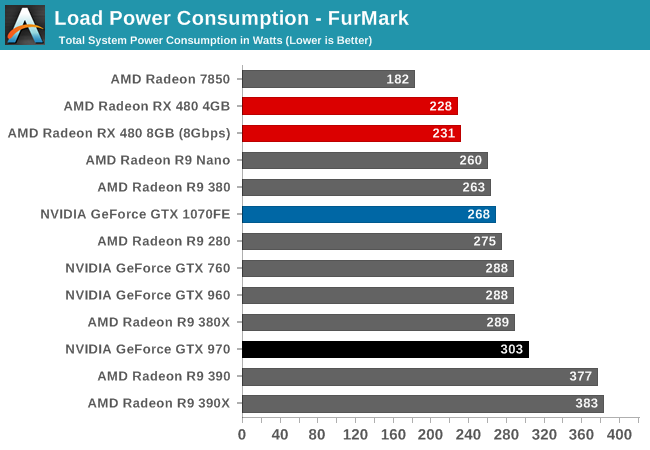
Traditionally we start with gaming load power before moving on to FurMark, but in this instance I want to flip that. As a power virus type workload, FurMark’s power requirements are greater than any game. But because it’s synthetic, it gives us a cleaner look at just GPU power consumption.
Among AMD’s cards, the RX 480 is second to only the Radeon HD 7850 in power consumption. Even then, as a GCN 1.0 card, the 7850 is one of the last AMD cards without fine-grained power states, so this isn’t a true apples-to-apples comparison. Instead a better point of reference is the GCN 1.2 based R9 Nano, which has a 175W TBP. Compared to the R9 Nano we find that the RX 480 draws about 30W less at the wall, which almost perfectly translates to the 25W difference in TBP. As a result we can see first-hand the progress AMD has made on containing power consumption with Polaris.
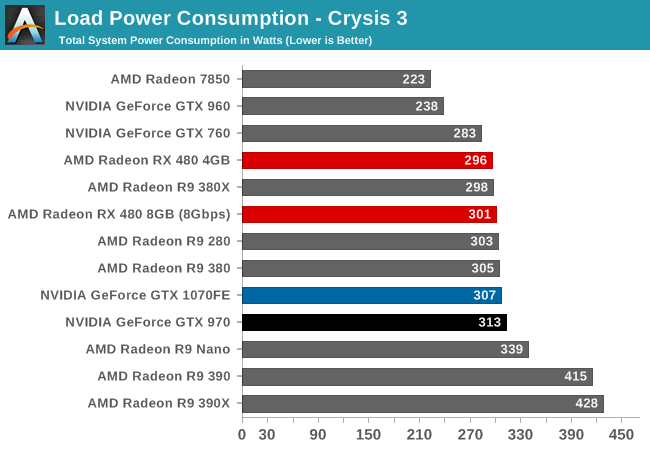
However things are a bit more mixed under Crysis 3. RX 480 is still near the top of our charts, and keeping in mind that higher performing cards draw more power on this test due to the additional CPU workload, the RX 480 compares very favorably to the rest of AMD’s lineup. System power consumption is very close to R9 280/380 for much improved performance, and against the performance-comparable R9 390, we’re looking at over 110W in savings. Hawaii was a solid chip from a performance standpoint, and Polaris 10 picks up where that left off by bringing down the power consumption to much lower levels.
The drawback for AMD here is that power consumption compared to NVIDIA still isn’t great. At the wall, RX 480 is only about 10W ahead of the performance-comparable GTX 970, a last-generation 28nm card. 1070FE further complicates matters, as its performance is well ahead of RX 480, and yet its power consumption at the wall is within several watts of AMD’s latest card. Given what we saw with FurMark I have little reason to believe that card-level power consumption is this close, but it looks like AMD is losing out elsewhere; possibly with driver-related CPU load.
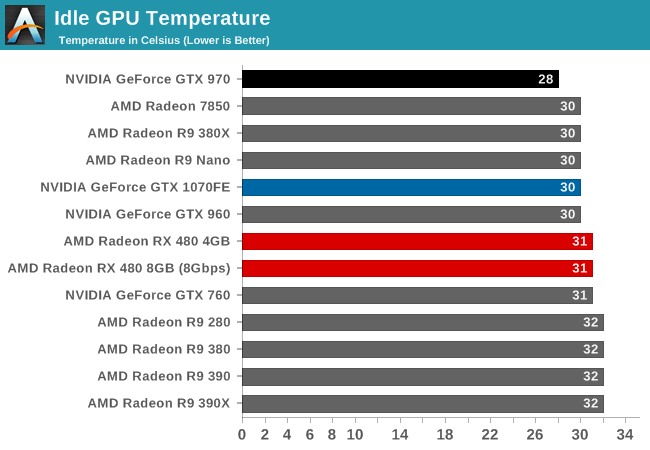
Moving on to idle GPU temperatures, there’s little to remark on. At 31C, the RX 480’s blower based design is consistent with the other cards in our lineup.
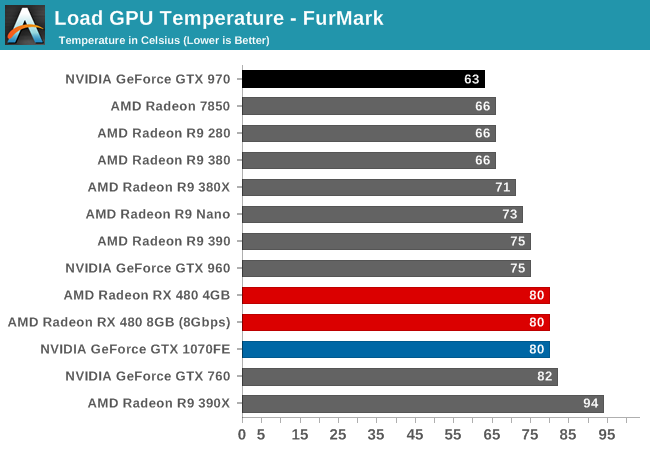
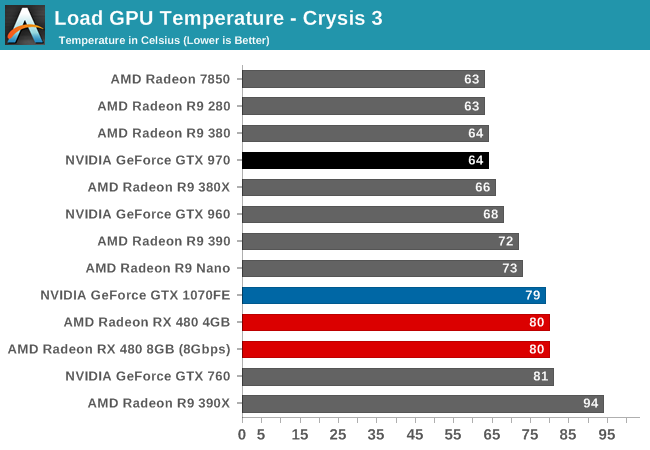
Meanwhile with load temperatures, we get to see the full impact of AMD’s new WattMan power management technology. The RX 480 has a temperature target of 80C, and it dutifully ramps up the fan to ensure it doesn’t exceed that temperature.

With idle noise levels RX 480 once again posts a good result. At 37.8dB, it’s in good company, only meaningfully trailing cards that idle silently due to their respective zero fan speed idle implementations.
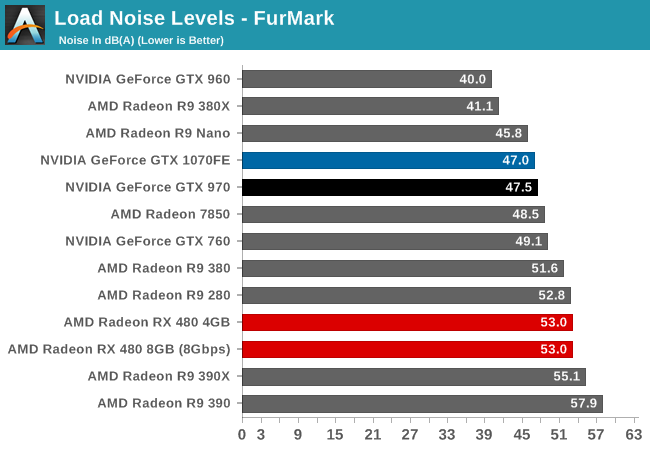
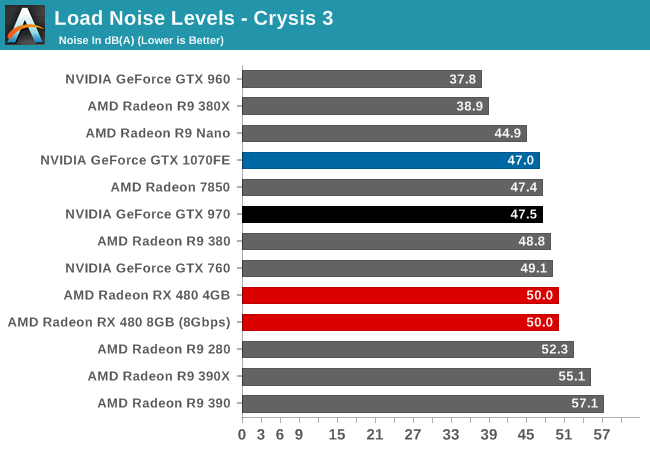
Finally, with load noise levels, RX 480 produces middling (but acceptable) results. Given that we have a mix of blowers and open air coolers here, the RX 480 performs similarly to other mainstream blower based cards. The $199 price tag means that AMD can’t implement any exotic cooling or noise reduction technologies, though strictly speaking it doesn’t need them.










449 Comments
View All Comments
stereopticon - Wednesday, June 29, 2016 - link
the gtx 970's price could easily be dropped to 240 to competesmilingcrow - Wednesday, June 29, 2016 - link
In the UK the 970 is already cheaper than the RX 480 8GB if you shop around which is where it should be priced I think.The RX 480 only has one redeeming feature but that's an important one; PRICE.
ptmnc1 - Wednesday, June 29, 2016 - link
Well, it *could*, I suppose. But the 970 is a 398mm² chip and the 480 is a 232mm² chip so AMD can make 1.7x as many from the same wafer even before accounting for yields. With similar memory systems there's no way for nVidia to win a price war at this performance level with its 28nm parts.DigitalFreak - Wednesday, June 29, 2016 - link
AMD has no monies to fight a price war. Nvidia could drive them out of the market right now if they wanted to. They won't because of monopoly concerns.ptmnc1 - Wednesday, June 29, 2016 - link
nVidia can't flog 970s below cost without various anti-dumping laws kicking in as well as the risk of having their company disassembled. Plus AMD would still be making a profit at that point.Yojimbo - Thursday, June 30, 2016 - link
I'm pretty sure that NVIDIA wouldn't have to sell the 970 for below cost to use it to compete or even undercut the current MSRP of the RX 480. NVIDIA's profit margins are significantly higher than AMD's to begin with. If NVIDIA prices the GTX 970 at just below the price as the RX 480, they probably sell more of them than AMD sells of the RX 480s. A price of the 970 GPU to AIB partners which would allow them to sell their card for $180 should not be below cost. I really don't know how such accounting works, but I am guessing that most of the research, development, and validation costs have already been amortized. Production cost of the chip really is not that much, comparitively. Surely regulators must recognize a cost advantage of a long-run production of a product.fanofanand - Thursday, June 30, 2016 - link
I'm not sure anti-dumping laws apply to obsolete (based on not being the latest) hardware. How else would a company be expected to clear out existing inventory prior to a product refresh?ptmnc1 - Thursday, June 30, 2016 - link
Yojimbo: The 970 has almost exactly the same memory system as the 4GB 480, the only differences in manufacturing costs are going to be the other parts of the board (e.g. VRMs) and the chip itself. The principal cost difference is going to be the chip, and when it's a 232mm² chip vs a 398mm² chip, the latter is going to cost a lot more to make even if yields on Samsung's 14LPP aren't as great as TSMC's 28nm: as long as they're not catastrophically worse (and there's no indication that's the case), there's just no way to build a 970 cheaper than a 4GB 480.On monopolies, you don't have to abuse one in order to attract a lot of undesirable attention from regulators.
fanoffanand: There's a difference between clearing existing obsolete inventory and deliberately manufacturing new inventory at a loss for the purpose of pushing a competitor out of business.
Yojimbo - Thursday, June 30, 2016 - link
The major cost of a chip is research, development, testing, and validation, not manufacturing costs. I assume these costs must be amortized over the life of the product. I am guessing that NVIDIA has already mostly done so, because they have sold a whole lot of chips already. You are worried about dumping, well how can the government come in and say NVIDIA is selling below cost when their research, development, testing, and validation costs logically apply over a run of 2 years, during which they already sold a high volume of chips?Regardless of whether it costs more or less for NVIDIA to make a 970 than AMD an RX 480 (I agree that the AMD RX 480 production costs should be lower), I feel confident in saying that NVIDIA doesn't need to sell at below cost to sell a 970 at a price below $200.
"On monopolies, you don't have to abuse one in order to attract a lot of undesirable attention from regulators."
Regulators don't just sit there and watch everything. NVIDIA would have to be sued for abuse of power, i.e., some company would need to be willing to spend money to oppose NVIDIA. If NVIDIA does not abuse its market position they shouldn't be too concerned with losing such a suit. If they don't plan on making any aquisitions in the GPU space then i think they don't need to worry about regulators. I'm mainly just repeating what I already said here, but you aren't saying what sort of "undesirable attention" you see NVIDIA getting or how it will affect them, so I'm not sure what else I can do.
fanofanand - Friday, July 1, 2016 - link
Nvidia isn't currently manufacturing new 970s.